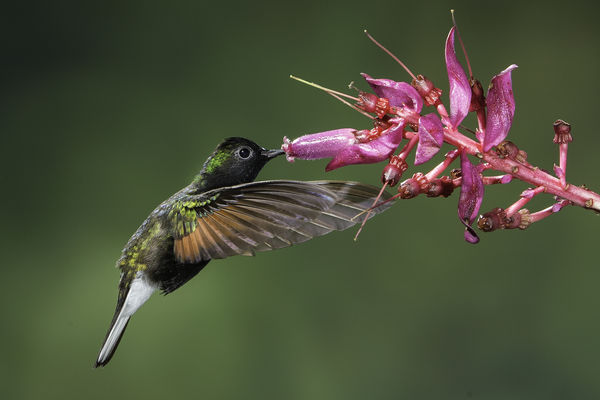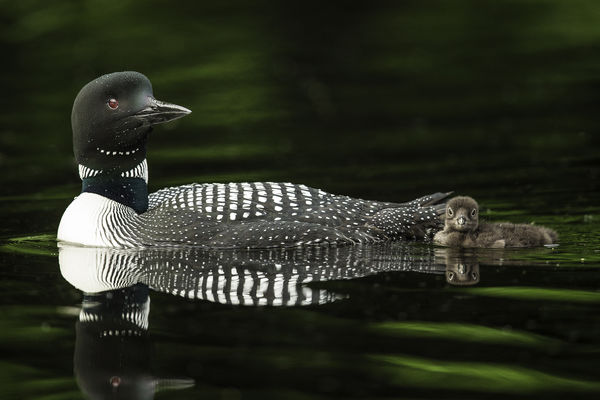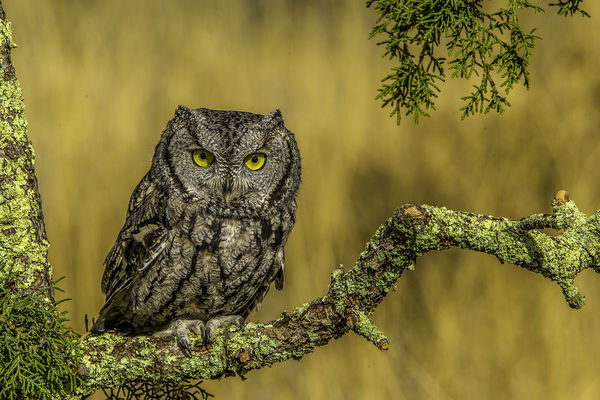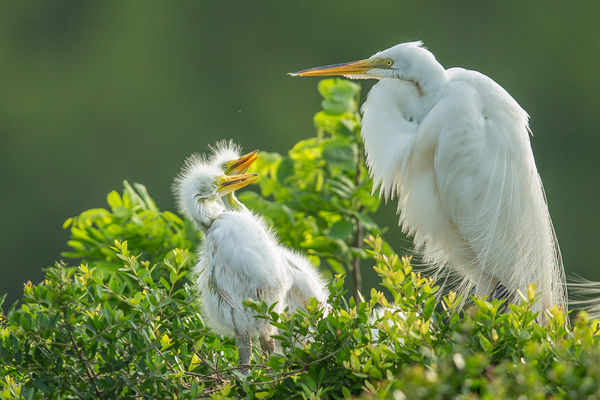How do you guys do it?
Nov 21, 2016 08:12:55 #
kpmac wrote:
Both. I use a 150-500mm Sigma and often crop photos I have taken at those focal lengths.


Nov 21, 2016 09:47:06 #
watebo wrote:
I see amazing images posted here of relatively small subjects such as birds. The aparent distance from camera to subject and the incredible sharpness and detail in the images impresses me. How do you guys and gals do it? Very long telephoto lenses or cropping?
Both, as well as knowledge and experience ....
Nov 21, 2016 09:48:21 #
Long lenses, cropping, high resolution cameras, good stability, high shutter speeds, low ISO, the right light, close proximity to your subject, good post processing techniques and ......................non of the above will do you any good without patience and perseverance.
.
.
Nov 21, 2016 10:00:21 #
Nalu wrote:
Long lenses, cropping, high resolution cameras, good stability, high shutter speeds, low ISO, the right light, close proximity to your subject, good post processing techniques and ......................non of the above will do you any good without patience and perseverance.
.
.


Nov 21, 2016 10:01:06 #
gvarner
Loc: Central Oregon Coast
watebo wrote:
I see amazing images posted here of relatively small subjects such as birds. The aparent distance from camera to subject and the incredible sharpness and detail in the images impresses me. How do you guys and gals do it? Very long telephoto lenses or cropping?
All the many references here to macro are technically misleading. What they're talking about is close-up which allows a much broader distance between focal plane and subject. In close-up photography, the distance can be spanned by getting physically closer, getting closer with a telephoto, or cropping in to produce a larger subject. At its extreme, a close-up can range all the way down to producing a subject that results in a 1:4 reproduction on the sensor, some say 1:2. Macro is any combination that can produce a 1:1 on the sensor whitch would exclude extreme cropping.
Nov 21, 2016 10:02:25 #
Hummingbirds are among the most fearless of birds, they KNOW you can't catch them! I've had ones come up to within an inch or two of my face or shirt, checking me out. I've also seen a hummer come within a few inches of our cat, who will sit or lay on the patio table when the hummers are feeding.
Cardinals, on the other hand, will seldom come within about 10 feet. I've had bluejays dive bomb me when eating outside, and I've seen one land a few feet away and bounce over to my plate to grab some food. Wrens are also pretty tolerant of humans, though a mother wren will scold you if you get too close to her hatchlings.
Swans and wild geese don't like it when you get too close to them, but rather than move away they'll attack you. Ducks in the park seem a bit more nonchalant.
Cardinals, on the other hand, will seldom come within about 10 feet. I've had bluejays dive bomb me when eating outside, and I've seen one land a few feet away and bounce over to my plate to grab some food. Wrens are also pretty tolerant of humans, though a mother wren will scold you if you get too close to her hatchlings.
Swans and wild geese don't like it when you get too close to them, but rather than move away they'll attack you. Ducks in the park seem a bit more nonchalant.
Nov 21, 2016 10:06:08 #
romanticf16
Loc: Commerce Twp, MI
In lectures from experienced nature photographers the emphasis is always knowing the behavior of what you are trying to capture.
Birds take off INTO the wind, do the opposite when landing. This allows you to anticipate what will happen and where. The same goes
for knowing the behavior of animals- never get between a mother bear and her cubs! And Don't get between a grizzly and his "stashed"
kill! Don't wear strong scents when looking for wildlife. Be patient and quiet, move slowly. In my region PBS (Public Television) broadcasts
several shows featuring experienced nature/wildlife photographers at work. See if you can find the local schedule and watch a few episodes.
Birds take off INTO the wind, do the opposite when landing. This allows you to anticipate what will happen and where. The same goes
for knowing the behavior of animals- never get between a mother bear and her cubs! And Don't get between a grizzly and his "stashed"
kill! Don't wear strong scents when looking for wildlife. Be patient and quiet, move slowly. In my region PBS (Public Television) broadcasts
several shows featuring experienced nature/wildlife photographers at work. See if you can find the local schedule and watch a few episodes.
Nov 21, 2016 11:17:00 #
I wouldn't want to get within a few hundred feet of a bear, period. My mother-in-law used to live on Lake Superior, she often had brown bears going through her garbage cans, even the so-called 'bear-proof' ones. Some of them she saw so often she had names for them.
My basic rule is, if it's bigger or meaner than me, stay away. I'll happily cede the WILD animal shots to others.
My basic rule is, if it's bigger or meaner than me, stay away. I'll happily cede the WILD animal shots to others.
Nov 21, 2016 13:12:27 #
RRS
Loc: Not sure
Gene51 wrote:
Like these?
Sooo Gene, what Bird Book did you copy these out of?? Lol, so now I know you do very good copy work too!! Great shots, 600mm/4.0 with maybe a 1.4?? Rained 26 days in October and November hasn't been all that much better, patiently awaiting some dry wx and some sunshine...
Nov 21, 2016 13:17:32 #
I think your question would be answered the simplest, probably the best way, if every contributor reveals the gear the image was taken with?
Nov 21, 2016 16:13:02 #
The first thing is to get as close as possible with as long a focal length as possible. Many great shots of small birds are taken at bird feeders, which presumably might be just 20 ft. or so from the photographer. If you can shoot from 15 or 20 ft away you should capture a lot of detail.
Having great equipment is a big help. If you have a D800 with a 600mm lens you are going to capture detail that a lesser camera and lens will not at the same distance.
ISO-100 will give you the cleanest shot.
Post processing and cropping can help bring out details and colors.
It helps to take some test shots to determine the best aperture and shutter speed, and take a lot of shots (known as "spray and pray").
And you need luck and patience.
That said, the following was taken handheld at about 50 ft. of a small bird on a 1" diameter fence pole, with a Nikon J1 camera, FT-1 adapter and Nikkor AFS VR 55-300mm lens, fully zoomed out to 300mm. Shot was taken at iso-100, f5.6, 1/640 sec.
Nikkor 55-300mm AFS VR lens fully zoomed. The J1's 2.7 crop factor gave an equivalent focal length of 810mm.
Having great equipment is a big help. If you have a D800 with a 600mm lens you are going to capture detail that a lesser camera and lens will not at the same distance.
ISO-100 will give you the cleanest shot.
Post processing and cropping can help bring out details and colors.
It helps to take some test shots to determine the best aperture and shutter speed, and take a lot of shots (known as "spray and pray").
And you need luck and patience.
That said, the following was taken handheld at about 50 ft. of a small bird on a 1" diameter fence pole, with a Nikon J1 camera, FT-1 adapter and Nikkor AFS VR 55-300mm lens, fully zoomed out to 300mm. Shot was taken at iso-100, f5.6, 1/640 sec.
Nikkor 55-300mm AFS VR lens fully zoomed. The J1's 2.7 crop factor gave an equivalent focal length of 810mm.
watebo wrote:
I see amazing images posted here of relatively small subjects such as birds. The aparent distance from camera to subject and the incredible sharpness and detail in the images impresses me. How do you guys and gals do it? Very long telephoto lenses or cropping?
Nov 21, 2016 16:28:40 #
Well, Bird photography has turned out to be very expensive for me; doubly so since my wife caught the fever as well. (but well worth it) The cost of really good photos, frequently involves trips to strange places, Long expensive lenses like a 600mm F4 lens and/or 300mm f2.8 lens, DSLR body that will shoot frames quickly (my 1DX is 14 frames/sec), and perhaps most importantly, attending a bird photography workshop, or just hang out with someone that knows what they are doing. Great photos with long expensive lenses doe not come easily (I discovered this to my great horror- it take very fussy technique as well) Fortunately, the Canon 7D mk2 has become a really good body for birds, with really great focusing and a multiplying factor on your lens since is it a crop frame sensor and it is more reasonable. While I think all agree that prime lenses are the best, some of the 150-600 zooms are getting pretty good and 1/10th the cost of a 600mm prime. Check out birdsasart.com and you can learn a lot.
All but the hummer were shot with the Canon 1DX and 600mm F4 Prime; the hummer with the 300mm f2.8 prime; the hummer and the egret were using a tripod, the owl was handheld, the loon was shot from a fishing boat and tripod. The Black Bellied Hummingbird was in Costa Rica, the Loon was north of Toronto, Canada, the owl was at Bosque del Apache in New Mexico, and the Egrets on the gulf coast of Texas. We greatly enjoy these trips and are planning more. Our next will be in May to Peru in the Amazon basin then to the galapagos islands. Super fun. And yes, I am very blessed to be able to have the health and means to do this, but you can start at the zoo. There the animals and birds are close, and it it not an expensive trip. I have some great shots at the zoo.
Good luck
Bill
All but the hummer were shot with the Canon 1DX and 600mm F4 Prime; the hummer with the 300mm f2.8 prime; the hummer and the egret were using a tripod, the owl was handheld, the loon was shot from a fishing boat and tripod. The Black Bellied Hummingbird was in Costa Rica, the Loon was north of Toronto, Canada, the owl was at Bosque del Apache in New Mexico, and the Egrets on the gulf coast of Texas. We greatly enjoy these trips and are planning more. Our next will be in May to Peru in the Amazon basin then to the galapagos islands. Super fun. And yes, I am very blessed to be able to have the health and means to do this, but you can start at the zoo. There the animals and birds are close, and it it not an expensive trip. I have some great shots at the zoo.
Good luck
Bill
Nov 21, 2016 17:09:58 #
Nov 21, 2016 18:02:19 #
wotsmith wrote:
Well, Bird photography has turned out to be very e... (show quote)
These are gorgeous images!
Nov 21, 2016 19:28:58 #
wotsmith wrote:
Well, Bird photography has turned out to be very e... (show quote)
Geesus Bill, that is the best photo of an owl I have ever seen. I mean I can reach out and touch him. You are one hell of a photographer.
If you want to reply, then register here. Registration is free and your account is created instantly, so you can post right away.














